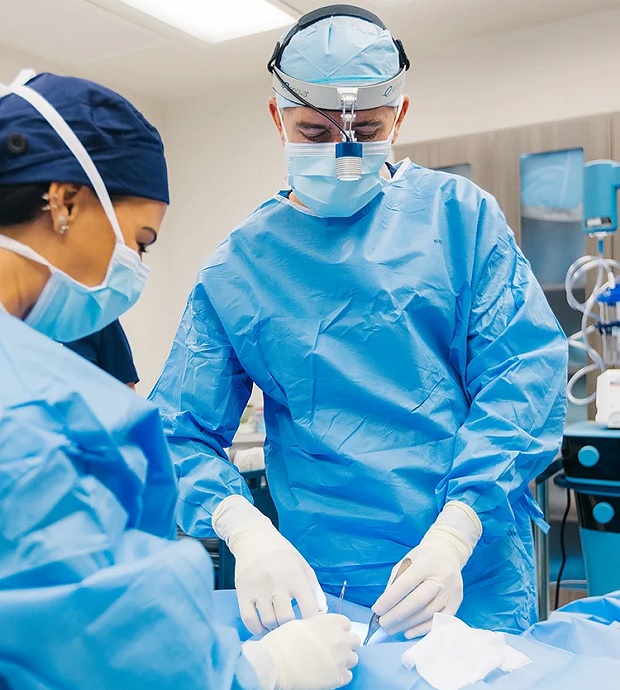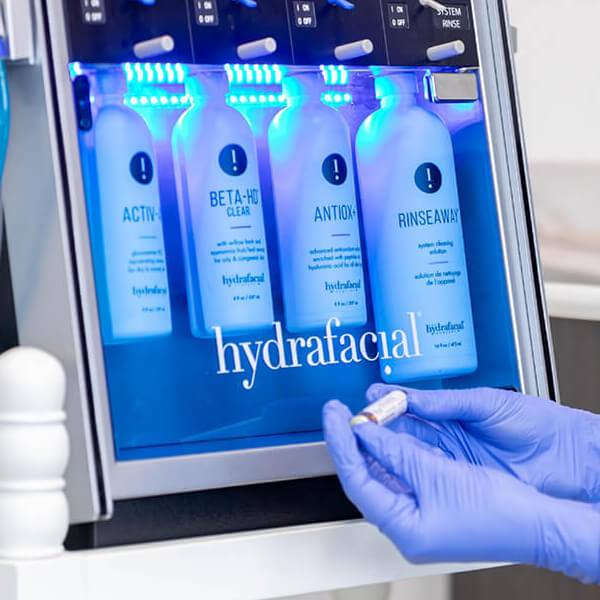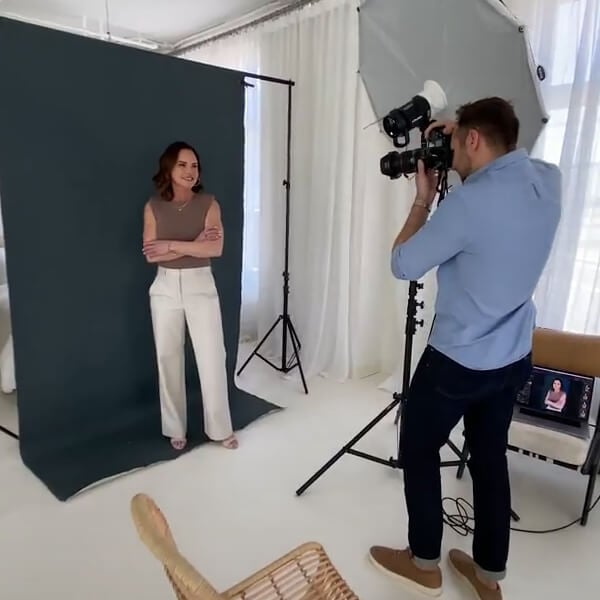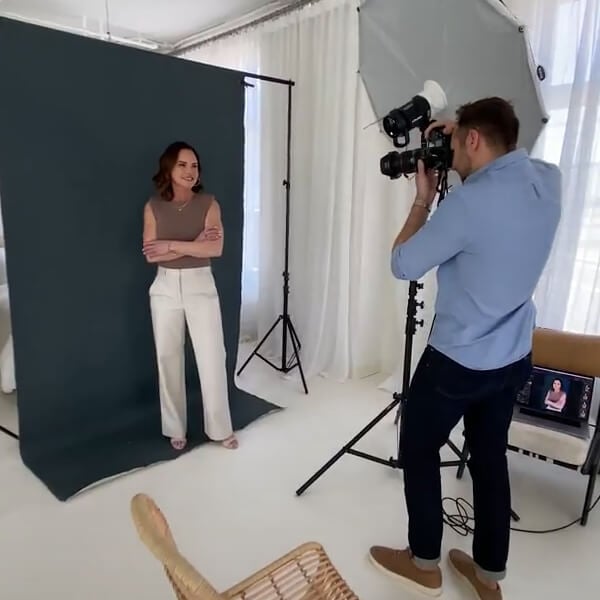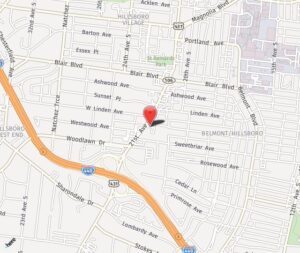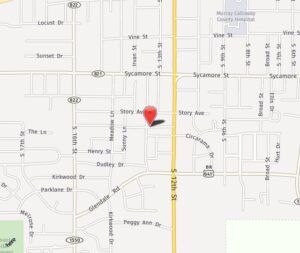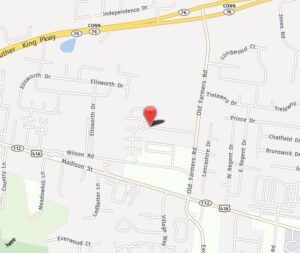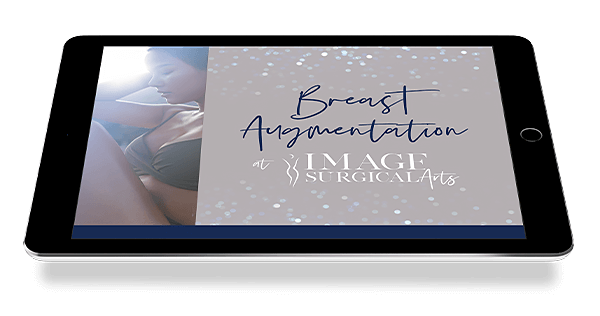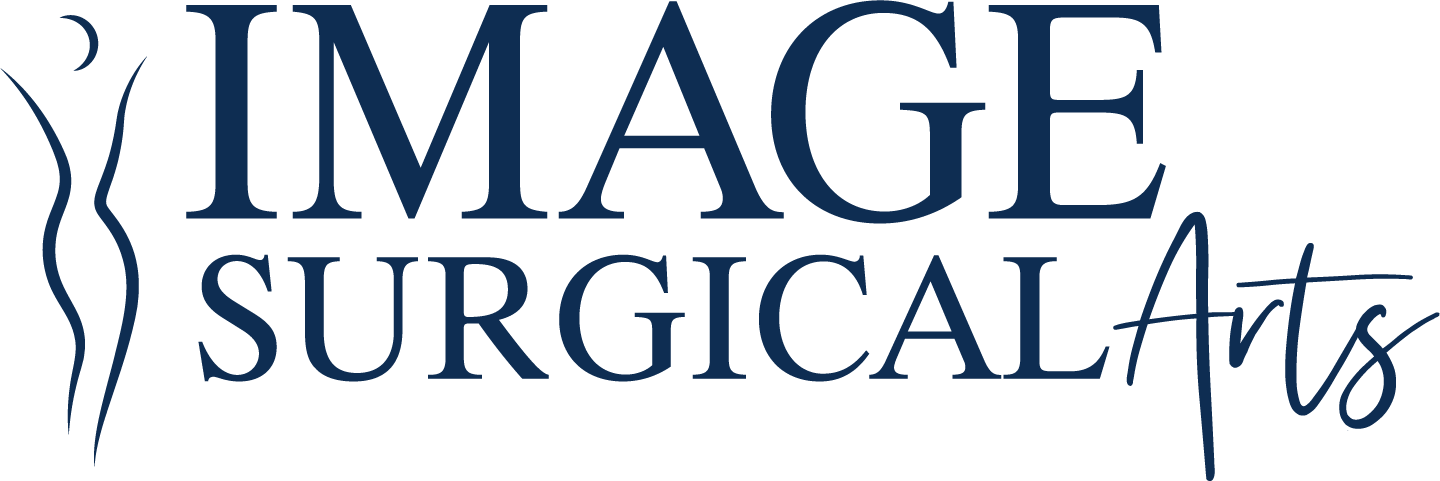SOLUTIONS BY DR. BRADY HARRIS
Let's Talk Breast Augmentation
The breast augmentation procedure, which is designed to enhance both the shape and size of the breasts, stands as one of the most sought-after cosmetic surgeries in the United States. Renowned for its remarkable effectiveness, stringent safety standards, and unparalleled customization options, it offers a path to renewed confidence for our patients.
When it comes to breast augmentation, patients have a choice between a wide array of breast implants, each crafted from high-quality silicone or saline. Implants typically range from 150cc to 800cc, offering a spectrum of sizes to suit individual preferences and aesthetic goals. Round implants excel at delivering a full, voluminous shape and accentuated cleavage, while form-stable ("gummy bear") implants offer a more natural, youthful contour with their sloping silhouette.
Nashville and Kentucky cosmetic surgeon Dr. Brady Harris has several surgical techniques in his arsenal to best address his patients’ preferences. The inframammary approach requires an incision along the lower breast fold; the peri-areolar approach places the incision around the nipple/areola; and the transaxillary approach inserts the implants through the armpit.
Benefits of a Breast Augmentation

You may enjoy many of the following benefits following breast augmentation:
- Added volume to the breasts
- Improved body proportions
- A more feminine body shape
- Enhanced appearance
- Higher self-confidence
- Correction of asymmetry issues
- Expanded wardrobe options
During your consultation, you'll establish a rapport with Dr. Harris to discuss your cosmetic objectives. Dr. Harris and his team will then curate a personalized surgical plan tailored to your goals. You'll have the opportunity to "try on" different breast implants to select the best fit, ensuring confidence before surgery.
You'll receive anesthesia for comfort during your procedure. Dr. Harris and his team strategically place incisions along natural body lines to minimize visible scarring. They prioritize both your health and aesthetic outcome, dedicating full attention to the surgery. Breast augmentations at Image Surgical Arts are performed as an outpatient procedure, allowing you to return home or to your hotel the same day. Wearing a compression garment aids in reducing swelling for a faster recovery. Dr. Harris schedules follow-up appointments to monitor your healing progress and provides guidance on gradually resuming activities like exercise.
Excellent Breast Augmentation Results from a World-Class Surgeon
Dr. Brady Harris is a triple board-certified cosmetic surgeon specializing in breast procedures. His extensive experience and education equips him with precision and a keen eye for aesthetic excellence. Dr. Harris takes pride in achieving natural and appealing results, tailored to fulfill each patient’s specific requests for enhanced confidence and satisfaction. Explore his before-and-after photo gallery to see the strength of his work.
Our breast augmentation prices start at $6,499! Financing options are available through CareCredit and Alphaeon, two leading medical lenders. To learn more about breast augmentation directly from one of Tennessee and Kentucky’s leading breast surgeons, schedule a consultation by calling 615-499-4224 today.
Frequently Asked Questions
What is a Breast Augmentation?
At Image Surgical Arts, we view breast augmentation as a generalized term because there are multiple options for augmenting, or enhancing, the breasts. Most commonly, breast augmentation is thought of as getting breast implants placed to increase the size of the breasts. An implant can not only increase breast size, but also enhance your cleavage.
There are other procedures we often implement to further enhance the breasts, either alone or in combination with implants. The right procedure depends on the condition of your breasts and what kinds of change you desire. For example, some women will have better results by adding a breast lift along with having an implant placed. A breast lift is designed to correct sagging by elevating and re-contouring the breast, whether or not the patient desires additional fullness.
We can also augment breasts by transferring fat from another part of the body, rather than using an implant. However, breast augmentation results from using an implant are often more natural-looking and uniform than with fat transfer.
Breast Implants - Type | Placement | Incisions
While the ultimate goal of any breast augmentation procedure is to enhance the aesthetic appearance of the breasts, there are different types of breast augmentation procedures. They involve different incision sites, different types of implants, and different areas of breast implant placement (on top of or underneath the chest muscle). Let’s examine each of our options for breast augmentation.
Implant Type
Broadly speaking, there are two different implant types: silicone and saline. We highly recommend silicone breast implants as they generally have a much more natural feel, and they significantly lower the risk of seeing “ripples” under the skin. However, the choice is ultimately yours when it comes to your preference of silicone or saline breast implants.
Within each type, especially with silicone, there are many different options including shapes, projection, textured or non-textured, and a wide variety of sizes. Implants are not only for women who want to dramatically increase the size of their breasts. We can use them to make relatively small, more subtle changes in breast fullness as well. All of these options can be discussed in detail at your consultation.
Implant Location
While it’s obvious the implant will be placed within the breast, the decision of whether to place the implant above or underneath the chest muscle is important. Rarely will Dr. Harris recommend placement above the muscle. There are several reasons for this:
- When the implant is placed under the muscle, it provides a more natural look since you will have both muscle and breast tissue covering all or part of the implant. It will also provide a more natural feel.
- Implants placed below the muscle will typically maintain their position longer since your chest muscles will help hold the implant in its place. When implants are placed above the muscle, the chest muscle does not provide any support for the implant, so the implants can sometimes “bottom out,” making the breasts appear heavy and less youthful.
- If you are getting a breast lift at the same time as your breast augmentation, it is critical to place the implant below the muscle so that the nipple and areola will have a more robust blood supply. Placing an implant above the chest muscle will disrupt many of the important blood vessels that supply nutrients and oxygen to the nipple and areola.
Incision Location
Now let’s examine the different incision sites that can be used for breast augmentation.
- By far, the incision location we use most often at is the inframammary fold (the fold under the breast where it meets the upper part of the abdomen). This is our preferred incision site because it disrupts only a minimal amount of breast tissue, allows for easy access to the chest muscle, and provides Dr. Harris with the best view of the tissues he needs to see for proper implant placement. The incision is very well hidden under a bra or bikini top, and generally no one will see it unless you want them to.
- Another possible incision location is the peri areolar incision. This incision is placed in a semi-circle that follows the contour of the lower half of the areola (the darker skin surrounding the nipple) where it meets the skin of the breast. This incision does not provide the visualization Dr. Harris desires, and it disrupts much more breast tissue as part of the procedure.
- Another location that can be used is the axillary incision. The axilla (arm pit) incision has a relatively high rate of wound break down, in which some of the sutured skin reopens. In addition, the tissue dissection is not as precise as with the inframammary incision site, and the implant does not have the ability to settle into a more natural position as you recover.
- The fourth incision site is through the belly button. There are significant limitations to this approach. Only saline implants can be used, and the dissection is completely blind, meaning the surgeon cannot physically see the tissue being dissected. Furthermore, the implant must be placed above the muscle. At Image Surgical Arts, we do not offer this option.
Whatever the details of your surgery, incisions do leave scars, though they will fade over time. Dr. Harris takes special care to make the smallest incisions possible without sacrificing his ability to do his best work for you. The exact location of your scars will depend on the specific method he uses for your breast augmentation and/or lift.
What About a Breast Lift?
While augmentation aims to enlarge breasts, the concern for many women is sagging. We usually associate this with pregnancy, breast-feeding, and aging (or with overly large and heavy breasts), but even teenagers can have naturally saggy breasts. The amount of droop can range from minor to severe, and it can be physically uncomfortable as well as aesthetically disappointing.
A breast lift can correct sagging, and for some women simply restoring a more youthful shape and position will also make the breasts appear somewhat larger. However, Dr. Harris often recommends adding implants to produce the most aesthetically pleasing result.
There are different incision patterns that can be used for a breast lift, depending on the final result desired. However the ultimate goal is to elevate the position of the nipple and areola so they are facing forward rather than downward, by removing excess skin as well as some breast tissue. If needed, Dr. Harris can also reduce enlarged areolae to produce a more visually balanced result. Which type of procedure is right for you is very personal and something you will discuss with Dr. Harris during your consultation.
What Does a Breast Augmentation Procedure Involve?
At Image Surgical Arts, we consider your breast augmentation procedure to include everything from your initial consultation all the way through to your final follow-up visit. There are a few steps to consider when planning your breast procedure.
Part 1 – Making the Decision
The decision to undergo cosmetic breast enhancement is not one that should be taken lightly. We are here to make the entire process as smooth as possible for you. At your initial consultation, you will meet with Dr. Harris and discuss what your goals are and how we can best achieve those goals.
During your consultation, we will review your past medical and surgical history and obtain all the information needed to make the actual procedure as safe as possible. Dr. Harris will perform a breast exam, take measurements of your breasts, and discuss all aspects of your breast augmentation procedure and the entire surgical process. You can ask all the questions you still have.
You will also have a chance to feel both types of implants (silicone and saline) to help decide which type you prefer. And depending on the procedure you choose, you may even be able to try on “sizers” to help you choose your implant size based on how you look with the sizers in place!
Part 2 – Setting the Date
Once you have decided that breast augmentation is right for you and Image Surgical Arts is the right practice for your procedure, we will schedule your surgery. We have our own state-accredited, office-based surgery center, so there is no need to go to a hospital. Our state-of-the-art surgery center offers a much more private setting than other types of centers. Less distracting bustle, more calming comfort. Plus, since all we do is cosmetic surgery, you won’t be exposed to other patients who have various other medical needs.
Part 3 – The Procedure Itself
Breast augmentation is an outpatient procedure, so you will arrive and go home the same day. Someone else will need to drive you. Here’s how it will go:
- When you arrive, we will welcome you with our usual friendly smiles. Today is your Big Day! We will bring you back to our pre-operative area, where you will be given IV sedation and/or general anesthesia as you previously discussed with Dr. Harris and the anesthesia team. This is a good time to ask any last-minute questions you might have.
- Dr. Harris will take “before” photos and draw the lines on your body for his surgical plan. Then we will transfer you to our operating suite, cleanse your skin to disinfect the surgical area, and cover you with sterile towels and drapes.
- Now Dr. Harris takes over, performing your procedure according to plan. It can take as little as one hour to perform a breast augmentation, but of course your procedure may take longer, especially if you are getting a lift as well. When he has finished, he will close your incisions, apply sterile dressings, and we will move you to our recovery room.
- You will probably be dressed in a special post-surgery compression bra and have to wear a garment like this for several days or weeks, depending on your procedure. This garment helps support your breasts, to ease any discomfort and, most importantly, to boost the healing process.
Part 4 – Heading Home
Following your procedure, you will go home to rest in your own bed. We will send you home with written post-procedure instructions, and our team will go over everything with you before you leave. For our patients who travel long distances, we will ask that you spend the night in a nearby hotel as we usually will see you back the next morning to make sure you are doing well and haven’t thought of any questions or have any concerns.
Questions Mothers Ask about Breast Augmentation
Whether you’re a relatively new mom or your kids are older now, whether you’re done having children or maybe not, mothers typically have specific questions and concerns about breast augmentation. Afterall, you're used to caring for others and you need to know how this procedure will effect your ability to continue doing so.
You want to know things like:
- Am I a good candidate for breast surgery?
- Is breast augmentation or a breast lift the best choice for me?
- Which implants are better -- saline or silicone?
- Will having surgery now affect my ability to breastfeed if I decide to become pregnant again?
- What does breast augmentation cost?
As you read through the information here, you should learn answers to most of your questions. Our free guide also answers four of the most common questions mothers and other women ask us.
It’s always good to make a written list of your questions. You will have many, and you don’t want to forget to ask, no matter how “small” the detail may seem to you. The better informed you are, the more confident you will be that whatever decision you make about breast augmentation will be the right one for you.
Who Is a Good Candidate?
If you are a woman who is not happy with the size of your breasts, or you’re feeling self-conscious about “deflated” or drooping breasts, an augmentation or lift may help you achieve the changes you desire. A good candidate for breast augmentation is someone who is a healthy non-smoker with realistic expectations.
If you do smoke, you will have to quit six weeks prior to your procedure and refrain from smoking during your recovery. Quitting smoking is not required for breast augmentation surgery but it is highly encouraged. A healthy pre-surgery lifestyle will help your body handle the procedure better and help you recover faster.
Nipple position is critical to your result. The best candidates are those whose nipples are higher than the fold underneath the breast. If your nipples are positioned below the fold (whether your breasts are sagging from breastfeeding, weight loss or other reasons) then you may be a better candidate for a breast augmentation with a breast lift.
Above all, realistic expectations are essential. Surgery can do amazing things, but there is no such thing as the perfect breast.
The best way to determine if you are a good candidate for a breast augmentation and/or breast lift is to schedule a complimentary in-person consultation with Dr. Harris. When you meet, he will go over every aspect of your procedure, perform a breast examination to determine which procedure will be best for your goals, take multiple breast measurements and answer all questions you have regarding the procedure and how to best meet your goals.
What Are the Risks and Side Effects?
All surgical procedures have associated risks. Breast augmentation surgery is no exception. Anytime the skin is cut, there is a risk of bleeding, infection, and injury to surrounding structures. Infection occurs when bacteria or other microorganisms are introduced to an area where they don’t normally live. The surface of our skin has millions and millions of bacteria.
Our priority at Image Surgical Arts is, and always will be, patient safety.
- We clean each patient’s skin with hospital grade antiseptic solution prior to every surgical procedure. As one of the only practices in the area to invest so extensively in building a state-accredited, office-based surgery center, we hold ourselves to the highest standards of cleanliness and sterilization. We know you are putting your trust in us.
- Our practice performs only cosmetic surgery. Unlike other surgery centers or hospitals where many different types of surgeries are performed (cosmetic surgery, urological surgery, colonoscopies, etc.), the fact that we are specialized allows us to limit potential cross-contamination and patient exposure more effectively.
- We maintain a small staff who are highly trained, specifically in cosmetic surgery procedures. This also limits the number of people our patients interact with, lowering the risk of exposure to different contaminants.
- To decrease risk of bleeding, Dr. Harris uses cautery (a special instrument to stop tissue bleeding) extensively as part of his dissections. Unfortunately, many surgeons will literally stick their finger under the muscle and sweep it back and forth blindly separating the tissues and then insert the implant. This technique leads to a higher rate of bleeding, hematomas (a pooling of blood under the skin) and the longer term complication of capsular contracture.
Your body will create a capsule anytime a foreign body is placed inside you (breast implant, artificial hip, etc.). Capsular contracture occurs when the capsule that your body forms around the breast implant becomes abnormally thick. This can lead to breast pain and breast deformity. While the cause of this has never been definitively proven, the two most common theories are blood left behind in the pocket the surgeon creates during the dissection (commonly seen with the “finger sweep” method) or a mild infection that may not cause any symptoms. Capsular contracture often requires revision surgery for correction.
There is a risk, albeit very low, of change in nipple sensation. This can include both decreased and increased nipple sensitivity. Rarely are the changes permanent. The risk is slightly higher when you combine breast augmentation with a breast lift.
Infected incisions from your breast augmentation procedure can occur as well. While these are usually not dangerous complications, they can be annoying. Dr. Harris and our team are available at all times to ensure your safety and satisfaction. This is our ultimate goal, and we pride ourselves on going above and beyond to prevent and treat any complications that may occur.
What Will Recovery Be Like?
Recovery from breast augmentation surgery is generally pretty straightforward. While every patient’s recovery will be a little different, everyone can expect to have some initial swelling or bruising and some discomfort for about five to seven days. Most patients describe any discomfort as soreness rather than pain. Often, they tell us that it feels like they went to the gym and worked out their chest really hard.
As part of your procedure, you will receive prescriptions for pain medicine and a muscle relaxer you can use at home. Most of our patients say the muscle relaxer actually provides more relief for any discomfort than the pain medication. That is because most of the soreness comes from the chest muscle being stretched due to the placement of the implant. Relaxing the chest muscle relieves the discomfort, keeping your recovery as easy as possible.
You will also receive instructions on when you can return to work and other routines of daily living as well as several things Dr. Harris wants you to avoid as part of your recovery process. Some examples include limitations on how much weight to lift, movements, and so on. These limitations are especially important for moms with younger kids, because you’ll need to avoid lifting your children! Dr. Harris will discuss these with you both before and after your breast augmentation procedure.
Ultimately the time it takes to fully recover depends on you because each person’s body is different. One really great tip is to set yourself up for recovery success prior to your surgery.
- You will need to have someone drive you home, but we also recommend that someone stay with you, at least for the first night. If you have young children, you will definitely need to recruit a stand-in (your spouse, older kids, or a friend) to tend to them for the first several days. The nicer you treat yourself during this early period, the smoother and faster your recovery will be.
- Set aside a space for your recovery headquarters – comfortable bed or seating where you can relax and rest with necessities such as water, the TV, your phone and charger, or a book right at hand.
- Plan ahead for healthy meals and ways to get the kind of exercise Dr. Harris recommends, because good nutrition and promoting good circulation are crucial to healthy, more comfortable recovery. That means no smoking! Smoking directly inhibits your body’s ability to heal.
What Does Breast Augmentation Cost?
One of the most important aspects of any cosmetic surgery procedure is the cost. Typically, breast augmentation here in the Nashville, TN area will range from $5,000 to $8,000. There are several factors that can affect the price of your own breast augmentation surgery. Chief among them are the details of your particular procedure, since the work to be done is individually tailored for every patient.
It is very important when you are comparing prices to make sure you are comparing apples to apples. Surgery quotes from different practices are not necessarily all-inclusive. Other practices may not include certain expenses in the initial quote, so you will be billed for services after your procedure. This means patients receive an extra bill for anesthesia or facility fees. It can be an unpleasant surprise.
At Image Surgical Arts, the price we quote you includes everything -- all necessary preoperative labs, surgeon fees, facility fees, anesthesia fees, postoperative visits, even your first postoperative bra. If there will be any additional costs for prescription medications, etc. we will let you know that up front as well.
We are able to keep our costs lower than many other practices because we own our own surgery center. This allows us to streamline our surgical process and keep costs down by focusing on exactly what is needed, without having to pay hospital fees. By performing only cosmetic surgery at our facility, we can limit the additional overhead otherwise required for rarely used supplies and pass those savings on to our patients.
The vast majority of cosmetic and plastic surgeons perform their procedures at hospitals or surgery centers where there are many other specialties also practicing. Because of this, your privacy is limited and your bill is usually higher.
At Image Surgical Arts, you will receive an all-inclusive quote at the time of your complimentary consultation. You will not receive a bill for anything after the fact.
Because cosmetic surgery is elective, medical insurance usually does not cover the cost. However, implants following a mastectomy are usually covered because they are considered medically necessary. It’s always a good idea to double-check with your insurance provider to be sure, because policies can vary widely. We know the procedure you want can be expensive, so we offer several financing options that may work for you.
Choosing the Right Surgeon
You may think that the biggest decision you have to make at this point is whether or not to move forward with having breast augmentation surgery. But if you decide yes, then your most important decision will be picking your surgeon. This is the person whose medical training and surgical skill will determine the outcome of your procedure.
This is the time to dig deep when doing your research – and the reason it’s so important to ask questions. The right surgeon will willingly and thoroughly answer those questions, and probably answer questions you didn’t know to ask.
Board certification is a must when you’re considering surgeons. It’s tough to become certified, but the surgeon who earns this designation has proven they have the knowledge, skill and dedication to do top quality work. You’ll find some who are not certified at all, because it’s optional. You will find surgeons certified by one medical board, or two. Dr. Brady Harris is triple board-certified. That alone speaks volumes about his dedication to his craft and to his patients.
Also look for a surgeon who specializes in breast augmentation because surgeons are not required to specialize. You don’t want someone whose primary experience is in some other part of the body, or performing some very different type of surgery. You need a surgeon who is intimately familiar with the complexities of breast anatomy. Someone who has successfully and repeatedly performed procedures just like the one you expect to have. There is simply no substitute for experience.
And one more thing. Back in the old days it was called “bedside manner,” but we’re talking about comfort level. You and the surgeon you choose will work as a team to develop exactly the right approach to achieving your breast enhancement goals. That won’t work if you don’t feel completely comfortable expressing your innermost concerns and desires honestly.
Good outcomes come from trust. Knowing you trust the surgeon you pick will give you peace of mind, and that will have a positive effect on your surgery, your recovery, and your satisfaction with the results.
About Image Surgical Arts
You may have found the best surgeon you can find, and that’s great news, but no matter how advanced the facility and the surgeon’s skill, he or she does not work alone. So while you’re considering qualifications and comfort level with surgeons, be sure to consider their entire practice.
Chances are good you will interact with most if not all the team members for one reason or another. That includes everything from friendly greetings on the phone to answering questions until you feel you have all the information you need.
The entire team should be just as open and honest with you as the surgeon. That’s the way we do things here at Image Surgical Arts, because helping you reach your aesthetic goals is our main mission. Learn more about each of our team members and get comfortable with our top-notch staff.
Breast Augmentation Results: Before and After Images
You will see the difference in your breasts right away following your augmentation surgery. As post-procedure swelling subsides, the new firmer, fuller you will become even more apparent. And in about four months you should see the final results of your procedure. Breast augmentation results typically last between eight and ten years, depending on the specifics of your surgery.
But what will those results look like?
Since there is no such thing as perfection, surgical satisfaction can depend on having realistic expectations. It’s virtually impossible to imagine the possibilities based on surgical descriptions alone, but you can get a very good idea of your own possible results by reviewing photos of other breast augmentation patients.
When you look at before and after pictures, it is important to be sure you are comparing yourself to those you see with similar body types. Look for before images of patients who have a similar breast size and nipple position as you currently have. Then you can look at their after photos to get an idea of what you might expect to achieve.
Before and after images of patients are also one of the most important parts of deciding which surgical practice is right for you. The more photos you view, the more you can learn about what is reasonable to expect. But the surgeon you choose to perform your breast procedure is crucial. So having a generic idea about results is not enough. You need to see what your prospective surgeon has accomplished for his or her own patients.
No two people are the same, which is why we tailor the treatment to each patient individually. Individual results will always vary, and you should never expect to have the exact same result as someone else. However, you can use our extensive before and after gallery as a guide to help you develop a realistic mental picture of how your revised breasts could look.
View our Before & after
Cosmetic Surgery Photos
Let Us Welcome You
IMAGE SURGICAL ARTS
Our Nashville clinic incorporates a 6,000 square foot, state-accredited surgery center. You never have to leave our office to benefit from the latest equipment, technology, and techniques.
At Image Surgical Arts, helping you safely reach your aesthetic goals is our main mission. We want you to have the safest, most advanced medical care possible. But we also want you to feel welcomed into our clinic and even a bit pampered, too. We want you to love every part of your experience, not just the final results.
Image Surgical Arts is here to help, every step of the way. Click on Request an Appointment to the right and schedule a private consultation with Dr. Harris. Together you can discuss your goals and explore options for achieving the new look you envision for your breasts.
